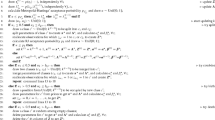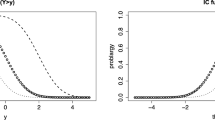Abstract
Dichotomous IRT models can be viewed as families of stochastically ordered distributions of responses to test items. This paper explores several properties of such distributions. In particular, it is examined under what conditions stochastic order in families of conditional distributions is transferred to their inverse distributions, from two families of related distributions to a third family, or from multivariate conditional distributions to a marginal distribution. The main results are formulated as a series of theorems and corollaries which apply to dichotomous IRT models. One part of the results holds for unidimensional models with fixed item parameters. The other part holds for models with random item parameters as used, for example, in adaptive testing or for tests with multidimensional abilities.
Similar content being viewed by others
References
Ahmed, A. N., León, R., & Proschan, F. (1981). Generalized association, with applications in multivariate statistics.Annals of Statistics, 9, 168–176.
Apostol, T. M. (1967).One-variable calculus, with an introduction to linear algebra (Vol. 1). New York, NY: Wiley.
Casella, G., & Berger, R. L. (1990).Statistical inference. Pacific Grove, CA: Wadsworth & Brooks/Cole.
Chuan, D. T., Chen, J. J., & Novick, M. R. (1981). Theory and practice for the use of cut-scores for personnel decisions.Journal of Educational Statistics, 6, 129–152.
Ellis, J. L. (1993). Subpopulation invariance of patterns in covariance matrices.British Journal of Mathematical and Statistical Psychology, 46, 231–254.
Ellis, J. L., & van den Wollenberg, A. L. (1993). Local homogeneity in latent trait models: A characterization of the homogenous monotone IRT model.Psychometrika, 58, 417–429.
Esary, J. D., Proschan, F., & Walkup, D. W. (1967). Association of random variables, with applications.Annals of Mathematical Statistics, 38, 1466–1474.
Fischer, G. H. & Molenaar, I. W. (Eds.) (1995).Rasch models: Foundations, recent developments, and applications. New York City, NY: Springer-Verlag.
Glas, C. A. W. (1992). A Rasch model with a multivariate distribution of ability. In M. Wilson (Ed.),Objective measurement: Theory into practice (Vol. 1). Norwood, NJ: Ablex.
Grayson, D. A. (1988). Two-group classification in latent trait theory: Scores with monotone likelihood ratio.Psychometrika, 53, 283–292.
Hambleton, R. K., & Swaminathan, H. (1985).Item response theory: Principles and applications. Boston, MA: Kluwer-Nijhoff Publishing.
Hemker, B. T., Sijtsma, K., Molenaar, I. W., & Junker, B. W. (1996). Polytomous IRT models and monotone likelihood ratio of the total score.Psychometrika, 61, 679–693.
Hemker, B. T., Sijtsma, K., Molenaar, I. W., & Junker, B. W. (1997). Stochastic ordering using the latent trait and the sum score in polytomous IRT models.Psychometrika, 62, 331–347.
Holland, P. W. (1981). When are item response models consistent with observed data?Psychometrika, 46, 79–92.
Holland, P. W. (1990). On the sampling theory foundations of item response theory models.Psychometrika, 55, 577–601.
Holland, P. W., & Rosenbaum, P. R. (1986). Conditional association and unidimensionality in monotone latent variable models.Annals of Statistics, 14, 1523–1543.
Huynh, H. (1994). A new proof for monotone likelihood ratio for the sum of independent Bernoulli random variables.Psychometrika, 59, 77–79.
Junker, B. W. (1991). Essential independence and likelihood-based ability estimations for polytomous items.Psychometrika, 56, 255–278.
Junker, B. W. (1993). Conditional association, essential independence, and monotone unidimensional item response models.Annals of Statistics, 21, 1359–1378.
Kelley, T. L. (1939). The selection of upper and lower groups for the validation of test items.Journal of Educational Psychology, 30, 17–24.
Lehmann, E. L. (1986).Testing statistical hypotheses (2nd ed.). New York, NY: Wiley.
Lord, F. M. (1980).Applications of item response theory to practical testing problems. Hillsdale, NJ: Lawrence Erlbaum.
Mislevy, R. J., & Wu, P.-K. (1988).Inferring examinee ability when some item responses are missing (Research Report 88-8). Princeton, NJ: Educational Testing Service.
Mokken, R. J. (1971).A theory and procedure of scale analysis. Den Haag, The Netherlands: Mouton.
Mokken, R. J. (1997). Nonparametric models for dichotomous responses. In W. J. van der Linden & R. K. Hambleton (Eds.),Handbook of modern item response theory (pp. 351–368). New York, NY: Springer-Verlag.
Mokken, R. J., & Lewis, C. (1982). A nonparametric approach to the analysis of dichotomous item responses.Applied Psychological Measurement, 6, 417–430.
Molenaar, W. (1997). Nonparametric models for polytomous responses. In W. J. van der Linden & R. K. Hambleton (Eds.),Handbook of modern item response theory (pp. 369–380). New York, NY: Springer-Verlag.
Ramsay, J. O. (1991). Kernel smoothing approaches to nonparametric item characteristic curve estimation.Psychometrika, 56, 611–630.
Ramsay, J. O. (1997).A functional approach to modeling test data. In W. J. van der Linden & R. K. Hambleton (Eds.),Handbook of modern item response theory (pp. 381–394). New York, NY: Springer-Verlag.
Reckase, M. D. (1997). A linear logistic multidimensional model for dichotomous item response data. In W. J. van der Linden & R. K. Hambleton (Eds.),Handbook of modern item response theory (pp. 271–286). New York, NY: Springer-Verlag.
Rosenbaum, P. R. (1984). Testing the conditional independence and monotonicity assumptions of item response theory.Psychometrika, 49, 425–435.
Rosenbaum, P. R. (1985). Comparing distributions of item responses for two groups.British Journal of Mathematical and Statistical Psychology, 38, 206–215.
Stout, W. F. (1987). A nonparametric approach for assessing latent trait unidimensionality.Psychometrika, 52, 589–617.
Stout, W. F. (1990). A new item response theory modeling approach with applications to unidimensionality assessment and ability estimation.Psychometrika, 55, 293–325.
Sijtsma, K. (1988).Contributions to Mokken's nonparametric item response theory. Unpublished doctoral dissertation, University of Groningen, The Netherlands.
Sijtsma, K., & Junker, B. W. (1994).A survey of theory and methods of invariant item ordering (Methods Series MS-94-4). Utrecht, The Netherlands: Department of Methodology and Statistics, Faculty of Social Sciences, Utrecht University.
Sijtsma, K., & Meijer, R. R. (1992). A method for investigating the intersection of item response functions in Mokken's nonparametric IRT model.Applied Psychological Measurement, 16, 149–158.
Stout, W. F. (1987). A nonparametric approach for assessing latent trait unidimensionality.Psychometrika, 52, 589–617.
Stout, W. F. (1990). A new item response theory modeling approach with applications to unidimensionality assessment and ability estimation.Psychometrika, 55, 293–325.
Tsutakawa, R. K., & Johnson, J. C. (1990). The effect of uncertainty of item parameter estimation on ability estimates.Psychometrika, 55, 371–390.
van der Linden, W. J. (1998). A decision theory model for course placement.Journal of Educational and Behavioral Statistics, 23, 18–34.
van der Linden, W. J., & Vos, H. J. (1996). A compensatory approach to optimal selection with mastery scores.Psychometrika, 61, 155–172.
Author information
Authors and Affiliations
Corresponding author
Additional information
Portions of this paper were presented at the 9th European Meeting of the Psychometric Society, Leiden, The Netherlands, July 4–7, 1995. The author is indebted to the referees for their comments on the previous version of the manuscript, as well as to the Greek fisherman who picked up the only copy of the set of handwritten notes for this paper from the harbor of Karpathos.
Rights and permissions
About this article
Cite this article
van der Linden, W.J. Stochastic order in dichotomous item response models for fixed, adaptive, and multidimensional tests. Psychometrika 63, 211–226 (1998). https://doi.org/10.1007/BF02294852
Received:
Revised:
Issue Date:
DOI: https://doi.org/10.1007/BF02294852




